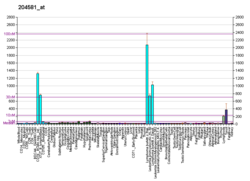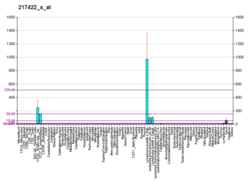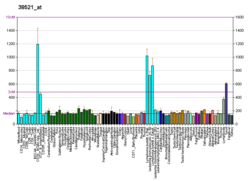
Back B-Zell-Rezeptor CD22 German CD22 Persian CD22 French CD22 Russian CD22 Tatar CD22 Ukrainian CD22 Vietnamese CD22 Chinese
| CD22 | |||||||||||||||||||||||||||||||||||||||||||||||||||
|---|---|---|---|---|---|---|---|---|---|---|---|---|---|---|---|---|---|---|---|---|---|---|---|---|---|---|---|---|---|---|---|---|---|---|---|---|---|---|---|---|---|---|---|---|---|---|---|---|---|---|---|
| Identifiers | |||||||||||||||||||||||||||||||||||||||||||||||||||
| Aliases | CD22, SIGLEC-2, SIGLEC2, CD22 molecule | ||||||||||||||||||||||||||||||||||||||||||||||||||
| External IDs | OMIM: 107266; MGI: 88322; HomoloGene: 31052; GeneCards: CD22; OMA:CD22 - orthologs | ||||||||||||||||||||||||||||||||||||||||||||||||||
| |||||||||||||||||||||||||||||||||||||||||||||||||||
| |||||||||||||||||||||||||||||||||||||||||||||||||||
| |||||||||||||||||||||||||||||||||||||||||||||||||||
| |||||||||||||||||||||||||||||||||||||||||||||||||||
| Wikidata | |||||||||||||||||||||||||||||||||||||||||||||||||||
| |||||||||||||||||||||||||||||||||||||||||||||||||||
CD22, or cluster of differentiation-22, is a molecule belonging to the SIGLEC family of lectins.[4] It is found on the surface of mature B cells and to a lesser extent on some immature B cells. Generally speaking, CD22 is a regulatory molecule that prevents the overactivation of the immune system and the development of autoimmune diseases.[5]
CD22 is a sugar binding transmembrane protein, which specifically binds sialic acid with an immunoglobulin (Ig) domain located at its N-terminus. The presence of Ig domains makes CD22 a member of the immunoglobulin superfamily. CD22 functions as an inhibitory receptor for B cell receptor (BCR) signaling. It is also involved in the B cell trafficking to Peyer's patches in mice.[6] In mice, it has been shown that CD22 blockade restores homeostatic microglial phagocytosis in aging brains.[7]

- ^ a b c GRCm38: Ensembl release 89: ENSMUSG00000030577 – Ensembl, May 2017
- ^ "Human PubMed Reference:". National Center for Biotechnology Information, U.S. National Library of Medicine.
- ^ "Mouse PubMed Reference:". National Center for Biotechnology Information, U.S. National Library of Medicine.
- ^ Crocker PR, Clark EA, Filbin M, Gordon S, Jones Y, Kehrl JH, et al. (February 1998). "Siglecs: a family of sialic-acid binding lectins". Glycobiology. 8 (2): v. doi:10.1093/oxfordjournals.glycob.a018832. PMID 9498912.
- ^ Hatta Y, Tsuchiya N, Matsushita M, Shiota M, Hagiwara K, Tokunaga K (April 1999). "Identification of the gene variations in human CD22". Immunogenetics. 49 (4): 280–6. doi:10.1007/s002510050494. PMID 10079291. S2CID 22947237.
- ^ Lee M, Kiefel H, LaJevic MD, Macauley MS, Kawashima H, O'Hara E, et al. (October 2014). "Transcriptional programs of lymphoid tissue capillary and high endothelium reveal control mechanisms for lymphocyte homing". Nature Immunology. 15 (10): 982–95. doi:10.1038/ni.2983. PMC 4222088. PMID 25173345.
- ^ Pluvinage JV, Wyss-Coray T, et al. (April 11, 2019). "CD22 blockade restores homeostatic microglial phagocytosis in aging brains". Nature. 568 (7751): 187–192. Bibcode:2019Natur.568..187P. doi:10.1038/s41586-019-1088-4. PMC 6574119. PMID 30944478.
© MMXXIII Rich X Search. We shall prevail. All rights reserved. Rich X Search




